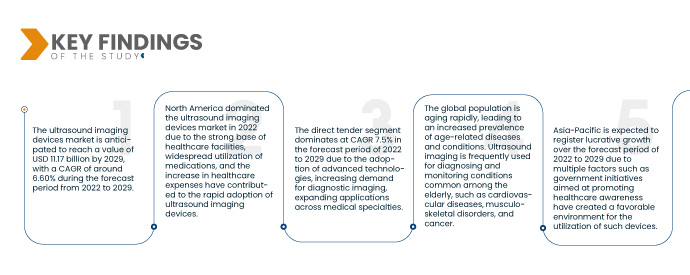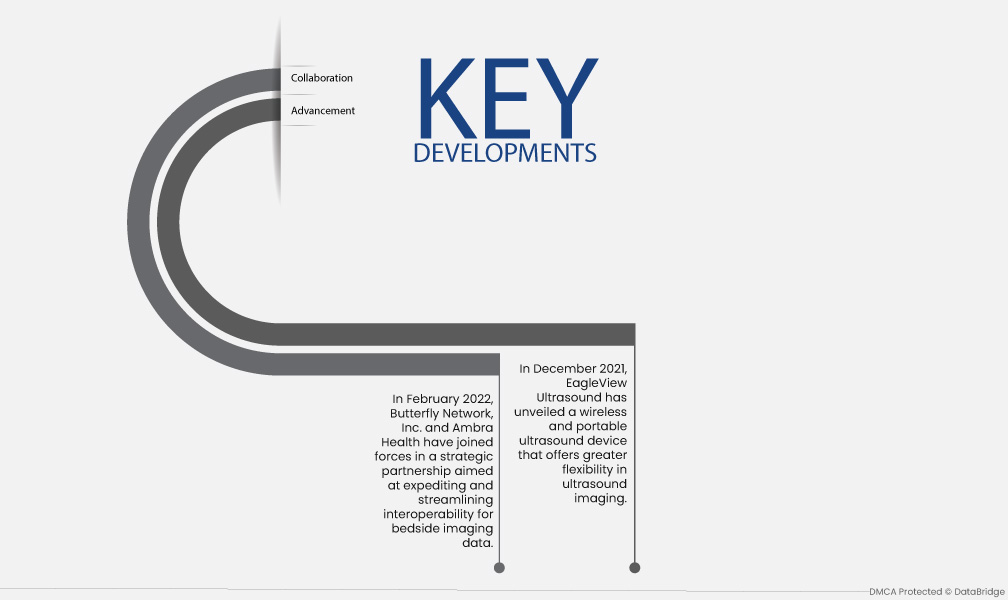Ultrasound imaging devices have diverse applications in healthcare. They are commonly used for obstetrics, cardiology, radiology, and musculoskeletal imaging. Features include real-time imaging, non-invasiveness, and portability. Ultrasound devices enable visualization of internal structures, monitoring of fetal development, assessment of cardiac function, detection of tumors, and guidance during minimally invasive procedures. They are crucial in diagnosing conditions such as gallbladder stones, liver diseases, and deep vein thrombosis. With their versatility and safety, ultrasound imaging devices have become indispensable tools for healthcare professionals in various medical specialties.
Access full Report @ https://www.databridgemarketresearch.com/es/reports/global-ultrasound-imaging-devices-market
Data Bridge Market Research analyses that the Global Ultrasound Imaging Devices Market is valued at USD 6.70 billion in 2021 and is expected to reach USD 11.17 billion by 2029, registering a CAGR of 6.60% during the forecast period of 2022 to 2029. The continuous advancements in ultrasound technology have significantly enhanced the capabilities and image quality of ultrasound devices. Innovations such as 3D and 4D imaging, portable and handheld devices, and improved software algorithms have expanded the application of ultrasound imaging across various medical specialties which drives the market’s growth.
Key Findings of the Study
Growing volumes of healthcare data is expected to drive the market's growth rate
The rising prevalence of chronic diseases like cardiovascular diseases, cancer, and gastrointestinal disorders has led to an increased demand for diagnostic imaging methods. Ultrasound imaging devices offer non-invasive and real-time imaging capabilities, making them highly valuable for the diagnosis and monitoring of various conditions. The growing burden of chronic diseases, the demand for ultrasound imaging devices has surged as healthcare professionals seek effective tools for accurate and timely diagnosis, thus driving the growth of the market.
Report Scope and Market Segmentation
|
Report Metric
|
Details
|
|
Forecast Period
|
2022 to 2029
|
|
Base Year
|
2021
|
|
Historic Years
|
2020 (Customizable to 2014-2019)
|
|
Quantitative Units
|
Revenue in USD Billion, Volumes in Units, Pricing in USD
|
|
Segments Covered
|
Array Format (Phased Array, Linear Array, Curved Linear Array and Others), Device Display (Color Ultrasound Devices and Black and White (B/W) Ultrasound Devices), Device Portability (Trolley/Cart-Based Ultrasound Devices, Compact/Handheld Ultrasound Devices, Stationary Ultrasound Devices and Point-of-Care Ultrasound Devices), Technology (Diagnostic Ultrasound and Therapeutic Ultrasound), Application (Radiology/General Imaging, Obstetrics and Gynecology, Cardiovascular, Gastroenterology, Vascular, Urological, Orthopedic and Musculoskeletal, Pain Management, Emergency Department, Critical Care and Others), End User (Hospitals, Surgical Centers, Research and Academia, Maternity Centers, Ambulatory Care Centers, Diagnostic Centers and Others), Distribution Channel (Direct Tender, Third Party Distributors and Retail Sales)
|
|
Countries Covered
|
U.S., Canada and Mexico in North America, Germany, France, U.K., Netherlands, Switzerland, Belgium, Russia, Italy, Spain, Turkey, Rest of Europe in Europe, China, Japan, India, South Korea, Singapore, Malaysia, Australia, Thailand, Indonesia, Philippines, Rest of Asia-Pacific (APAC) in the Asia-Pacific (APAC), Saudi Arabia, U.A.E, South Africa, Egypt, Israel, Rest of Middle East and Africa (MEA) as a part of Middle East and Africa (MEA), Brazil, Argentina and Rest of South America as part of South America.
|
|
Market Players Covered
|
General Electric (U.S.), Koninklijke Philips N.V. (Netherlands), Canon Medical Systems Corporation (Japan), Hitachi, Ltd. (Japan), Siemens Healthineers AG (Germany), Hologic, Inc. (U.S.), FUJIFILM Holdings Corporation (Japan), Samsung Electronics Co., Ltd. (South Korea), Mindray Medical International Limited (China), Analogic Corporation (U.S.), Esaote S.p.A (Italy), Carestream Health (U.S.), CURA Healthcare (India), Chison Medical Technologies Co., Ltd. (China), Mobisante, Inc. (U.S.), Neusoft Corporation (China), Clarius Mobile Health (Canada), Medgyn Products, Inc. (U.S.), and United Imaging Healthcare Co., Ltd. (China)
|
|
Data Points Covered in the Report
|
In addition to the insights on market scenarios such as market value, growth rate, segmentation, geographical coverage, and major players, the market reports curated by the Data Bridge Market Research also include depth expert analysis, patient epidemiology, pipeline analysis, pricing analysis, and regulatory framework
|
Segment Analysis:
The ultrasound imaging devices market is segmented on the basis of array format, device display, device portability, technology, application, end user and distribution channel.
- On the basis of array format, the market is segmented into phased array, linear array, curved linear array and others. In 2022, curved linear array segment is expected to dominate the global ultrasound imaging devices market with a CAGR of 6.4% in the forecast period of 2022 to 2029 as curved linear array transducers are versatile and can be used across various medical specialties.
In 2022, the curved linear array segment is dominating the array format segment of the global ultrasound imaging devices market
In 2022, the curved linear array segment is dominating the market with a CAGR of 6.4% in the forecast period of 2022 to 2029 as curved linear array transducers are designed to provide high-quality images with a wide field of view, making them suitable for a variety of applications. These transducers offer versatility and flexibility, allowing healthcare professionals to perform imaging procedures in different areas of the body.
- On the basis of device display, the market is segmented into color ultrasound devices and black and white (B/W) ultrasound devices. In 2022, the color ultrasound devices segment is expected to dominate the global ultrasound imaging devices market with the CAGR of 6.4% in the forecast period of 2022 to 2029 as color doppler imaging provides valuable information about blood flow patterns, direction, and velocity.
In 2022, the color ultrasound devices segment is dominating the device display of the global ultrasound imaging devices market
In 2022, the color ultrasound segment is dominating the component segment with a CAGR of 6.4% in the forecast period of 2022 to 2029 of the global ultrasound imaging devices market as color ultrasound technology enables the visualization of blood flow within the body, providing valuable information about vascular structures and perfusion patterns. This feature is particularly useful in various medical specialties, including cardiology, obstetrics and gynecology, and vascular medicine.
- On the basis of device portability, the market is segmented into trolley/cart-based ultrasound devices, compact/handheld ultrasound devices, stationary ultrasound devices and point-of-care ultrasound devices. In 2022, trolley/cart-based ultrasound devices dominate the market at CAGR 6.5% in the forecast period of 2022 to 2029 as trolley/cart-based ultrasound devices offer a wide range of advanced features and functionalities.
- On the basis of technology, the market is segmented into diagnostic ultrasound and therapeutic ultrasound. The therapeutic ultrasound segment dominates at CAGR 7.5% in the forecast period of 2022 to 2029 as these devices utilize ultrasound waves for therapeutic purposes, such as promoting tissue healing, reducing pain, and aiding in rehabilitation.
- On the basis of application, the market is segmented into radiology/general imaging, obstetrics and gynecology, cardiovascular, gastroenterology, vascular, urological, orthopedic and musculoskeletal, pain management, emergency department, critical care and others. The critical care segment dominates at CAGR 6.6% in the forecast period of 2022 to 2029 due to its wide range of applications and the need for real-time imaging in critical care settings.
- On the basis of end user, the market is segmented into hospitals, surgical centers, research and academia, maternity centers, ambulatory care centers, diagnostic centers and others. The hospitals segment dominates at CAGR 7.1% in the forecast period of 2022 to 2029 as these facilities are equipped with a wide range of ultrasound imaging devices to cater to various diagnostic needs.
- On the basis of distribution channel, the market is segmented into direct tender, third party distributors, and retail sales. The direct tender segment dominates at CAGR 7.5% in the forecast period of 2022 to 2029 due to the adoption of advanced technologies, increasing demand for diagnostic imaging, and expanding applications across medical specialties.
Major Players
Data Bridge Market Research recognizes the following companies as the major ultrasound imaging devices market players in ultrasound imaging devices market are General Electric (U.S.), Koninklijke Philips N.V. (Netherlands), Canon Medical Systems Corporation (Japan), Hitachi, Ltd. (Japan), Siemens Healthineers AG (Germany), Hologic, Inc. (U.S.), FUJIFILM Holdings Corporation (Japan)
Market Developments
- In February 2022, Butterfly Network, Inc. and Ambra Health have joined forces in a strategic partnership aimed at expediting and streamlining interoperability for bedside imaging data. This collaboration reinforces the scalability of Butterfly Network's enterprise platform, known as Butterfly Blueprint, and aims to improve the accessibility and sharing of essential ultrasound information among hospitals and health systems.
- In December 2021, EagleView Ultrasound has unveiled a wireless and portable ultrasound device that offers greater flexibility in ultrasound imaging. This innovation allows healthcare providers to perform ultrasound examinations with increased freedom and mobility, particularly in point-of-care settings.
Regional Analysis
Geographically, the countries covered in the ultrasound imaging devices market report are U.S., Canada and Mexico in North America, Germany, France, U.K., Netherlands, Switzerland, Belgium, Russia, Italy, Spain, Turkey, Rest of Europe in Europe, China, Japan, India, South Korea, Singapore, Malaysia, Australia, Thailand, Indonesia, Philippines, Rest of Asia-Pacific (APAC) in the Asia-Pacific (APAC), Saudi Arabia, U.A.E, South Africa, Egypt, Israel, Rest of Middle East and Africa (MEA) as a part of Middle East and Africa (MEA), Brazil, Argentina and Rest of South America as part of South America.
As per Data Bridge Market Research analysis:
North America is the dominant region in ultrasound imaging devices market during the forecast period 2022 - 2029
In 2022, North America dominated the ultrasound imaging devices market due as these devices are widely utilized in healthcare facilities due to their non-invasiveness, real-time imaging capabilities, and cost-effectiveness. Additionally, the prevalence of kidney stones has been increasing, further driving the demand for ultrasound imaging devices as they are a valuable tool for diagnosing and monitoring this condition. The combination of these factors, along with a rising number of research activities in the field, has propelled the utilization and advancements of ultrasound imaging devices in healthcare settings.
Asia-Pacific is estimated to be the fastest growing region in ultrasound imaging devices market the forecast period 2022 - 2029
Asia-Pacific is expected to grow during the forecast period due the rise in medical tourism has attracted patients seeking high-quality healthcare services, leading to increased demand for advanced diagnostic technologies like ultrasound imaging. Moreover, the region's growing research activities contribute to the continuous advancements and innovation in this field. The presence of massive untapped markets, coupled with a large population pool and an increasing demand for quality healthcare, further drives the adoption and growth of ultrasound imaging devices in the region.
For more detailed information about the ultrasound imaging devices market report, click here – https://www.databridgemarketresearch.com/es/reports/global-ultrasound-imaging-devices-market














